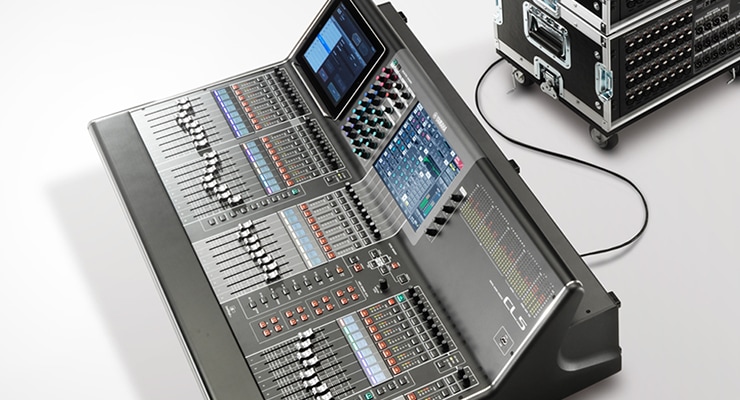Better Sound for Commercial Installations
Part 2: Amplifers and Speakers
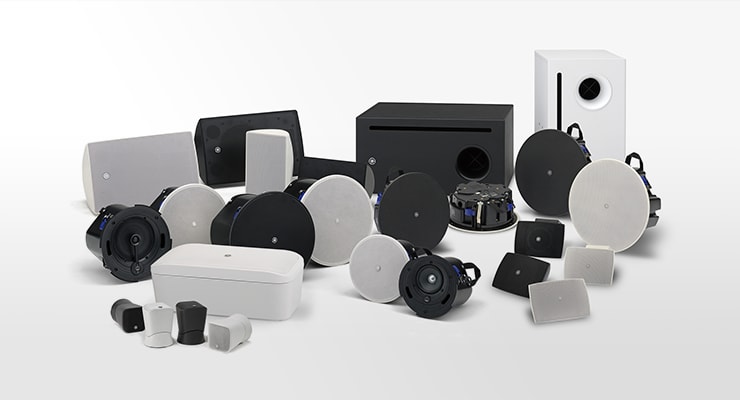
01. Types of Speaker Systems
Speaker systems are usually the first choice to be made when planning a sound system. Important points to consider are the size and purpose of the room in which the speaker system is to be used, and the interior design. Let's start by looking at some of the types of speaker systems most commonly used in commercial facilities, and how they are installed.
Speaker Systems Used In Commercial Installations
The types of speaker systems most commonly used in commercial installations can be broadly organized into the following three categories.
Surface Mount Speaker Systems
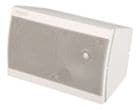
These are usually speaker systems in a box-type enclosure that are mounted on a wall or ceiling. Surface mounting is the most basic speaker installation method. Surface mounted speakers are sometimes used for primary output in small to medium size facilities, or as secondary support speakers in large halls or event spaces where the main speakers alone aren't able to provide sufficient intelligibility throughout the entire listening area (at the back of the hall, for example). They are also sometimes used to distribute announcements and BGM throughout the facility (see "Speaker Layout and Sound Pressure Level").
In product catalogs you'll notice that surface mount speakers are available in "2-way" and "3-way" variations. This indicates how the overall audio frequency range is divided up and output via the speaker units. 2-way speaker systems divide the audio spectrum into two bands that will be separately output via corresponding speaker units, while 3-way speaker units divide the audio spectrum into three bands. 2-way types are often chosen for small to medium commercial sound installations.
(Figure: An example of a 2-way surface mount speaker system (Yamaha S15W))
Ceiling Speakers
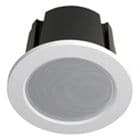
Ceiling speakers are built into the ceiling so that they are flush with the ceiling surface. This type of installation is ideal in situations where the speakers are to be hidden so that they won't disrupt the interior décor, and is a common choice for distributing BGM throughout a facility (see "Speaker Layout and Sound Pressure Level"). The broad coverage and relative lack of directionality of ceiling speakers is an advantage for the latter application. Ceiling speakers are sometimes used in a supplemental support role in larger installations, in the same way that surface mount speakers are.
(Figure: Ceiling speaker (Yamaha S5))
Column Speakers
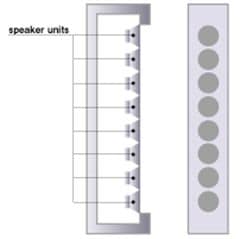
Column speakers consist of numerous speaker units of the same type arranged vertically in a column-like enclosure. With the speaker units arranged in this way vertical sound spread toward the floor and ceiling is reduced, and that can help suppress unwanted reflections. This arrangement also results in less diffusion of the sound energy, and therefore less loss of output level (see "Speaker Layout and Sound Pressure Level"). Column speakers are often used in churches, gymnasiums, and other facilities where excessive reverberation might be a problem, as well as in conference rooms and lecture halls where maximum speech intelligibility is the main goal.
(Figure: Column speaker construction)
Specialized Speaker Systems
The speaker systems introduced above are the types most commonly found in commercial sound installations. Now let's take a look at two more speaker system types that have even more specialized applications.
Subwoofers
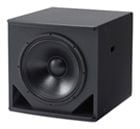
Subwoofers are designed specifically to handle ultra-low frequencies that cannot be effectively reproduced by standard speaker systems. The low frequencies output by subwoofers are more felt than heard, and can add significantly to the perceived power and impact of the sound. Subwoofers are most commonly used in facilities that cater primarily to music events. As we learned in "Part 1 - Sound Basics," low frequencies are not directional, so subwoofers can be placed in just about any convenient location.
(Figure: A subwoofer (Yamaha IS1118))
Large Sound Reinforcement Speakers
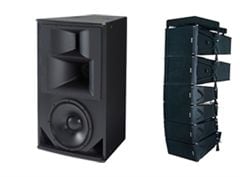
These types of speakers are necessary to provide the required sound pressure levels in large-scale installations such as theaters, halls, and stadiums. Wide range and high output speaker systems, and line arrays that are basically an evolved type of column speaker are commonly used.
(Figure (left): A large speaker system (Yamaha IF3115)
Figure (right): A line array speaker system (NEXO GEO D System))
Installation Options for Surface Mount Speakers

Compared to relatively straightforward ceiling and column speaker installation, the method used to install surface mount speakers must be carefully chosen to allow optimum position and angle adjustment using the available architecture for support. For that reason a variety of mounting hardware options are usually available so that the installation can be optimally matched to the facility.
(Figure: From left, Ceiling bracket, Wall bracket, Baton bracket, Suspension ("flying"), and U-bracket)
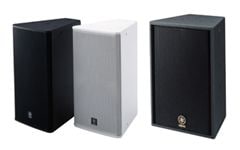
Another consideration for commercial installations is the visibility of speaker systems. Surface mount speakers are more obvious than ceiling or column types, and can have significant impact on décor and atmosphere. The imposing visual presence of speaker systems can be a mood-enhancing element at music events and live performances, but in banquet halls, for example, it's usually better to make speaker hardware blend in rather than stand out.
Yamaha Installation Series speakers are offered in black or white finishes, so you can select the color that will have minimum impact on the facility's décor. The Concert Club series enclosures are paintable, so they can be finished in any color for a perfect visual match.
Figure (left): Yamaha Installation Series speaker systems available in black or white (Yamaha IF2112)
Figure (right): Paintable Concert Club VC Series enclosure (Yamaha C112VA)
That's it for the types of speakers most commonly used in commercial sound installations. Product catalogues include a large variety of types and variations, but all will generally fall into the categories described above. Coming up next: speaker positioning.
Contents
The sound systems that broadcast the information you're hearing have been carefully designed and installed to suit the needs of each individual facility.
This series offers information aimed at achieving the best possible sound in commercial installations, from the basics to equipment selection and day-to-day operation.


